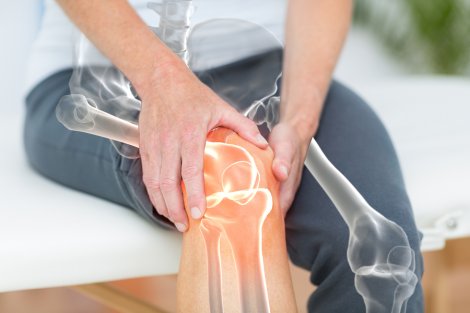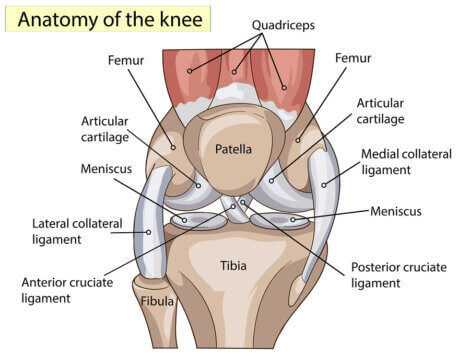Knee Arthritis and The Causes

One of the most common cases in a trauma consultation is knee pain. This kind of pain is often muscle or tendon originated. Other times, there may be a degeneration of the knee joint, which is known as knee arthritis.
Knee arthritis is a potentially limiting condition that must be evaluated and treated by a specialist physician. In today’s article, you’ll learn more about what arthritis is and what can cause it.
Knee arthritis
The term ‘arthritis’ refers to inflammation of the joint tissue. In the case of knee arthritis, the lining tissue over the knee joint swells. This is a cartilaginous type of tissue; it covers the knee bones and ligaments and allows for smooth movement so that these structures don’t rub against each other, which would cause them to erode.
There are several types of knee arthritis, but the most common by far is osteoarthritis or knee osteoarthritis.
The knee joint
The knee joint is one of the most complex joints in the body. It’s made up of various bones, ligaments, and muscle-tendon structures. The following is a simple anatomical summary that makes it easier to understand how arthritis affects this particular joint:
Bones
There are three bones in the knee joint:
- At the upper level and in proximity to the torso, there’s the longest bone in the body: the femur.
- On the opposite side, at a lower and distal level, there are the tibia and the fibula.

- This structure also has a small pseudospherical bone: the patella or kneecap, which connects to the quadriceps muscle tendons.
These three bones bind to each other by joints. In the areas where they’re in contact, there’s a cartilaginous tissue that covers the bone edges, so that when the joint moves, there’s no harsh friction between the bones.
In osteoarthritis, this cartilaginous tissue becomes inflamed and damaged. Over time, it erodes and the layer becomes thinner and thinner. This causes friction between the bones with movement, which in addition to causing pain, damages the bone tissue.
Ligaments and tendons
There are four very important ligaments in this joint:
- The most important one is the anterior cruciate ligament.
- On the back of the joint is the posterior cruciate ligament.
- On the outer part of the knee is the fibular collateral ligament.
- Finally, on the inner side of the knee, there’s the medial collateral ligament.
These four ligaments are arranged as pillars and provide support and mobility to the knee. In addition, the knee connects to tendons from all sides of the quadriceps muscle, which converge into a single one that connects to the kneecap, and then goes down to the tibia.
Degeneration of the cartilage that protects the joint will expose these structures to friction and traumatic injuries. Therefore, osteoarthritis can trigger ligament tears or tendon injuries.

Causes of knee arthritis
Currently, experts have doubts about what exactly causes knee arthritis. In the case of osteoarthritis, however, evidence links the condition to aging. At an older age, there’s a higher prevalence of osteoarthritis of the articular cartilage.
In theory, humans lose elements that replace the cartilaginous matrix of the joint with age, so certain movements damage it and it can’t be reconstructed.
Other possible causes for osteoarthritis are the following:
- Obesity is one of the factors that’s usually present in people who develop arthritis. Increased body weight compresses the joint and causes more damage to the cartilage.
- Very intense exercise. Strength exercises such as squats, if not performed correctly and without the necessary resting periods, can damage the articular cartilage.
- Repetitive microtrauma. Even if the exercise isn’t intense, repetitions that involve stress on the knee can cause small constant injuries that damage the cartilage.
Finally, it’s also important to mention another possible triggering factor for knee arthritis: daily chores that involve putting all the weight on the knee could also contribute to the joint becoming injured. In any case, following the treatment indicated by a professional is essential to reduce pain.
One of the most common cases in a trauma consultation is knee pain. This kind of pain is often muscle or tendon originated. Other times, there may be a degeneration of the knee joint, which is known as knee arthritis.
Knee arthritis is a potentially limiting condition that must be evaluated and treated by a specialist physician. In today’s article, you’ll learn more about what arthritis is and what can cause it.
Knee arthritis
The term ‘arthritis’ refers to inflammation of the joint tissue. In the case of knee arthritis, the lining tissue over the knee joint swells. This is a cartilaginous type of tissue; it covers the knee bones and ligaments and allows for smooth movement so that these structures don’t rub against each other, which would cause them to erode.
There are several types of knee arthritis, but the most common by far is osteoarthritis or knee osteoarthritis.
The knee joint
The knee joint is one of the most complex joints in the body. It’s made up of various bones, ligaments, and muscle-tendon structures. The following is a simple anatomical summary that makes it easier to understand how arthritis affects this particular joint:
Bones
There are three bones in the knee joint:
- At the upper level and in proximity to the torso, there’s the longest bone in the body: the femur.
- On the opposite side, at a lower and distal level, there are the tibia and the fibula.

- This structure also has a small pseudospherical bone: the patella or kneecap, which connects to the quadriceps muscle tendons.
These three bones bind to each other by joints. In the areas where they’re in contact, there’s a cartilaginous tissue that covers the bone edges, so that when the joint moves, there’s no harsh friction between the bones.
In osteoarthritis, this cartilaginous tissue becomes inflamed and damaged. Over time, it erodes and the layer becomes thinner and thinner. This causes friction between the bones with movement, which in addition to causing pain, damages the bone tissue.
Ligaments and tendons
There are four very important ligaments in this joint:
- The most important one is the anterior cruciate ligament.
- On the back of the joint is the posterior cruciate ligament.
- On the outer part of the knee is the fibular collateral ligament.
- Finally, on the inner side of the knee, there’s the medial collateral ligament.
These four ligaments are arranged as pillars and provide support and mobility to the knee. In addition, the knee connects to tendons from all sides of the quadriceps muscle, which converge into a single one that connects to the kneecap, and then goes down to the tibia.
Degeneration of the cartilage that protects the joint will expose these structures to friction and traumatic injuries. Therefore, osteoarthritis can trigger ligament tears or tendon injuries.

Causes of knee arthritis
Currently, experts have doubts about what exactly causes knee arthritis. In the case of osteoarthritis, however, evidence links the condition to aging. At an older age, there’s a higher prevalence of osteoarthritis of the articular cartilage.
In theory, humans lose elements that replace the cartilaginous matrix of the joint with age, so certain movements damage it and it can’t be reconstructed.
Other possible causes for osteoarthritis are the following:
- Obesity is one of the factors that’s usually present in people who develop arthritis. Increased body weight compresses the joint and causes more damage to the cartilage.
- Very intense exercise. Strength exercises such as squats, if not performed correctly and without the necessary resting periods, can damage the articular cartilage.
- Repetitive microtrauma. Even if the exercise isn’t intense, repetitions that involve stress on the knee can cause small constant injuries that damage the cartilage.
Finally, it’s also important to mention another possible triggering factor for knee arthritis: daily chores that involve putting all the weight on the knee could also contribute to the joint becoming injured. In any case, following the treatment indicated by a professional is essential to reduce pain.
All cited sources were thoroughly reviewed by our team to ensure their quality, reliability, currency, and validity. The bibliography of this article was considered reliable and of academic or scientific accuracy.
- Heidari B. Knee osteoarthritis prevalence, risk factors, pathogenesis and features: Part I. Casp J Intern Med. 2011 Mar;2(2):205–12.
- Loeser RF. The Role of Aging in the Development of Osteoarthritis. Vol. 128, Transactions of the American Clinical and Climatological Association. 2017. p. 44–54.
- Artrosis de rodilla: qué es, síntomas, diagnóstico y tratamiento [Internet]. [cited 2020 Jan 7]. Available from: https://inforeuma.com/enfermedades-reumaticas/artrosis-de-rodilla/
- Artritis de rodilla [Internet]. [cited 2020 Jan 7]. Available from: https://www.sanitas.es/sanitas/seguros/es/particulares/biblioteca-de-salud/Lesiones/lesion-osea/artritis-rodilla.html
- Shane Anderson A, Loeser RF. Why is osteoarthritis an age-related disease? Vol. 24, Best Practice and Research: Clinical Rheumatology. 2010. p. 15–26.
This text is provided for informational purposes only and does not replace consultation with a professional. If in doubt, consult your specialist.








